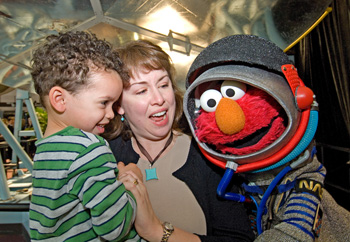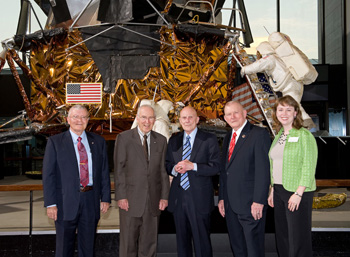'Star Wars' passion was job credential for Margaret Weitekamp '01

Margaret Weitekamp '01 with her son and the "Elmonaut" at the Smithsonian during a press event announcing the "One World, One Sky" planetarium show. Photo by Mark Avino/Smithsonian National Air and Space Museum.
Margaret Weitekamp, Ph.D. '01, grew up as a fan of "Star Trek" and "Star Wars." "Now all of that TV and movie watching has turned out to be a job credential," says Weitekamp, who has been curator of popular culture for the Smithsonian's National Air and Space Museum in Washington, D.C., since 2004.
The popular culture collections in the Division of Space History include space science fiction as well as the popular and material culture of the actual U.S. space program, such as hats, buttons, T-shirts, commemorative coins and awards. The collection has about 4,000 objects.
The 11-foot model of the starship Enterprise, used in the opening shot of the original "Star Trek" TV show, is one object that keeps Weitekamp on her toes. "Trek fans are so passionate about the subject and notoriously famous for their attention to detail," she says. "I like working with the model because it has that living feel of something that's still really important to people. Curators don't think any of our objects are dusty old things that go on a shelf, but that's one in particular that the public still believes really has a life."

Margaret Weitekamp '01 with the Apollo 13 crew on the night of the 2010 Glenn lecture she organized and moderated. Photo by Mark Avino/Smithsonian National Air and Space Museum.
Weitekamp is also fond of a space charm bracelet that belonged to the wife of an engineer; it embodies her particular strengths in space and women's history. "I'm interested in how ordinary people have interacted with the space program," she says, "and I'm interested in memorabilia that isn't pristine from a collector but, in fact, carries the stories of families and individuals who were excited about the space program."
The breadth of space history appeals to Weitekamp. "I like the intellectual challenge of juggling the top-down and bottom-up politics, as well as society and culture and science and technology all at the same time," she says.
Weitekamp says Cornell, where she earned master's and doctoral degrees in the field of history under the guidance of Richard Polenberg, Marie Underhill Noll Professor of History, prepared her to seek out intellectual challenges. "I had the freedom and support to follow my interests where they went," she says. She also had the opportunity to create a first-year writing seminar on space history and science fiction for the John S. Knight Writing Program, a course she taught again as an assistant professor of women's studies at Hobart and William Smith Colleges.

The 11-foot model of the starship Enterprise, used in the opening shots of the original "Star Trek" TV show, on display in the Smithsonian's gift shop. Photo by Linda Glaser/Provided.
When the Smithsonian advertised for a cultural historian with knowledge of space science fiction and space history, Weitekamp had the ideal on-resume teaching experience.
Weitekamp's work now extends beyond teaching and writing. As the lead curator on the interactive exhibit "Space for You," she developed the list of 30 behind-the-scenes jobs in the space force, ranging from librarian to scuba diver, to which participants are assigned based on a survey. She and her husband, Kevin Michael Days '94, came up with the creative survey question: "Which superhero trait would you like to have?"
And when Hollywood came calling, Weitekamp was ready. She was invited to visit the set during the filming of "Night at the Museum 2: Battle of the Smithsonian."
Curator of Human Spaceflight Valerie Neal says Weitekamp "has a playful sense about her. She's very good at thinking of ways that things can appeal to children and families."
Since most of the objects at the Smithsonian come from donations (Weitekamp has no purchasing budget), one of her primary responsibilities is deciding which objects are suitable for the national collection. "Margaret brings to such decisions a scholar's expertise and a critical eye," says Roger Launius, senior curator of the Division of Space History. "She's been providing a rigor to the analysis of popular culture objects that we had not been able to do here previously."

Detail of the space toys exhibit at the Smithsonian. Photo by Linda Glaser/Provided.
Neal agrees, pointing to Weitekamp's current project with space toys. "Some people might consider toys in the collection frivolous, but there's value here in terms of understanding our culture and how people relate to the space program," says Neal. "Because Margaret's a serious scholar, she can give them intellectual credibility."
Weitekamp's first book, "Right Stuff, Wrong Sex: America's First Women in Space Program," was based on her dissertation and examined the role gender assumptions played in high-level political decisions during the Cold War space race. Her current book project, "The Space Craze," is the history of America's fascination with space flight -- inspired, naturally, by her job as curator.
Linda B. Glaser is a staff writer for the College of Arts and Sciences.